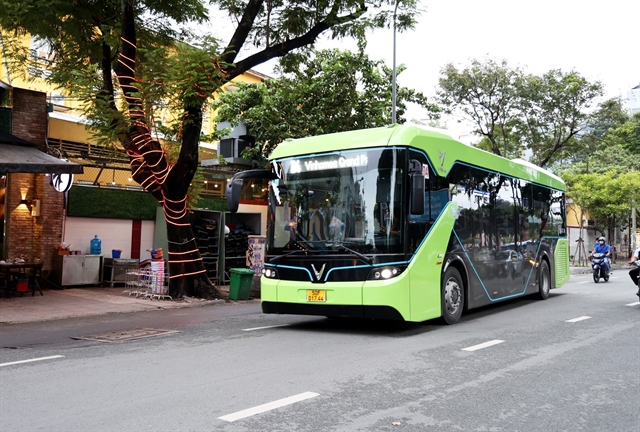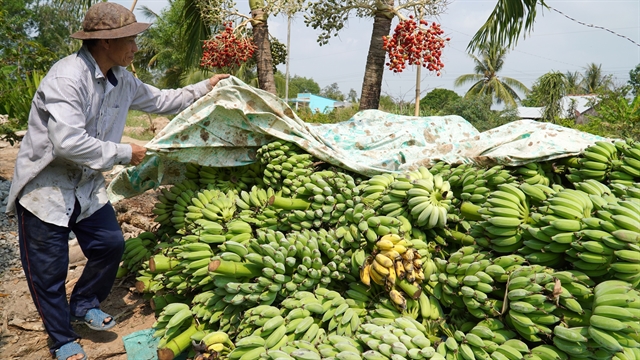 Environment
Environment

 |
| A farmer harvests Siamese bananas in U Minh Thượng District, in the Mekong Delta province of Kiên Giang.—VNA/VNS Photo Văn Sĩ |
KIÊN GIANG — The production of banana fibre and handicraft items derived from it has opened up a new avenue of income for banana growers in U Minh Thượng District, in the Mekong Delta province of Kiên Giang.
For over two decades, the Siamese banana has been the dominant crop in the buffer zone of U Minh Thượng National Park, which covers more than 2,700ha.
The area has long been dubbed the province's "banana kingdom".
Since 2023, while earning a stable income from selling banana bunches and banana flowers, local farmers have also begun repurposing banana trunks — once discarded or used as livestock fodder — into fibre for handicraft weaving and textile yarns.
The initiative has not only created jobs, but also increased incomes for local residents.
The Kênh 10 Agricultural Production and Services Cooperative, based in Minh Thuận Commune, U Minh Thượng District, stands out as one of the province’s most effective cooperatives in recent years.
In addition to securing output contracts for a variety of produce such as ginger, sweet potatoes, bananas and other fruit, since 2023 the cooperative has invested over VNĐ1 billion (US$38,400) in greenhouses and machinery to process banana trunks.
This includes splitting machines, fibre extractors, pulp presses and fibre spinning equipment.
Cooperative Director Trần Thị Vỹ said that after more than 15 years trading agricultural products in the district, especially bananas and banana blossoms, she realised that hundreds of thousands of banana trunks were being discarded after harvesting the fruit.
Only a small portion was used as poultry feed, with the vast majority left to rot, representing a huge waste.
Inspired to make better use of this by-product, she conducted extensive research via media, field studies and consultations with technical experts.
Elsewhere, people weave household items such as mats, bags, trays and baskets from water hyacinth or sedge, she said.
“I realised that banana fibre, extracted from sun-dried banana sheath, is flexible, durable and eco-friendly, perfect for weaving and textiles. So I gave it a try, and the results were promising,” she said.
Encouraged by this early success, Vỹ invested in processing equipment and secured contracts with companies to purchase the fibre.
This year, the cooperative signed an order to produce 4,000 banana fibre mats for export to Japan.
Raising incomes
The cooperative’s fibre processing workshop now purchases banana trunks at VNĐ1,000 ($0.03) per trunk if pre-cut by the growers, or VNĐ500 ($0.015) if the workshop staff harvest them.
The workshop employs 10 local workers, each earning around VNĐ6 million ($230) per month.
More than 50 other people are also contracted to weave handicraft products from the fibres for export.
Workshop employee Danh Minh said his family cultivates two hectares of Siamese bananas and harvests around 7,000 trunks annually, generating an extra income of about VNĐ6 million ($230).
He also earns VNĐ200,000–250,000 ($7.50-9.50) per day at the fibre workshop, which has helped stabilise his family's finances.
Another banana grower, Danh Chênh, expressed his delight at being able to sell banana trunks to the cooperative, earning over VNĐ10 million ($384) a year.
With revenue from selling banana bunches, flowers, leaves and trunks, his total annual income now exceeds VNĐ250 million ($9,600).
Chênh's family has four hectares of Siamese bananas. Every year, he used to discard about 14,000 banana trunks.
“It felt wasteful, but I had no alternative. I hope the cooperative continues expanding so more growers can benefit,” he said.
Vỹ said several companies have expressed interest in commissioning banana fibre products such as floor mats, handbags, trays and bins, or in purchasing raw banana fibre.
This presents a significant opportunity for scaling up fibre processing and handicraft production.
The cooperative is currently working with relevant agencies to launch vocational training courses for local women in handicraft weaving.
It also aims to expand production capacity and secure stable export markets, primarily in Europe, where demand for eco-friendly products is high, she added.
However, the cooperative still faces challenges, particularly in terms of capital for investing in machinery, especially dryers and greenhouses.
“We’re hopeful that authorities will offer financial support so we can expand our operations,” Vỹ said.
Nguyễn Việt Trung, Vice Chairman of the People's Committee of the district, said the cooperative's initiatives in agricultural procurement, banana fibre processing and handicraft production are helping farmers increase the value of their crops.
The efforts enhance product competitiveness, meet market demands, boost revenue and profits, and create stable employment and income for locals.
He also said the cooperative’s model aligns with the district’s development strategy for agriculture, small-scale industries and services, especially given the region’s extensive banana cultivation.
In the next few years, local authorities plan to continue working with relevant departments to implement supportive policies, facilitating the cooperative’s growth.
Special attention will be paid to financing, equipment, infrastructure and the application of scientific and technological advancements in production and business operations.— VNS




